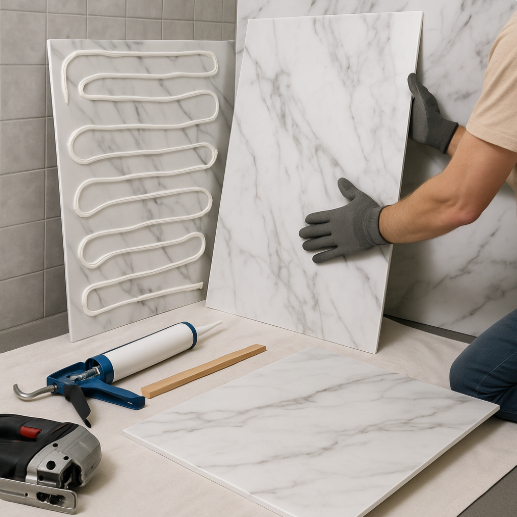Table of Contents
I remember the exact second I decided to stop overthinking and start installing. It was 8:17 p.m., the bathroom fan was humming, and I was standing there with a full-size PVC marble sheet propped against the tub like a surfboard. I kept telling myself, “It’s just one panel. Glue, press, breathe.” If you’re at that same moment half excited, half terrified this is the version of the guide I wish I’d had: no fluff, just what it actually felt like to do the job, the tools that mattered, and the tiny habits that kept me from muttering words my neighbors don’t need to hear.
The moment before you start: set the stage
The most honest part of this whole project happens before any adhesive touches a wall. Every little ripple and bump behind a glossy panel becomes a headline once it’s installed. I cleared the room like I was about to paint plates off outlets, hooks and trim removed, anything that could catch a panel gone. Then I cleaned like a person who has made peace with elbow grease: degreaser in the kitchen, a scale remover in the shower, and two plain-water rinses so no cleaners lingered.
The test that saved me? I slid a 1-meter level across the wall and listened. Where it clicked, I skim-coated dips with compound; where it scraped, I sanded proud spots down. If your wall looks fine but sounds wavy under a level, believe your ears. Ten quiet minutes here are worth a year of not seeing a weird shadow across a “finished” wall.
Tools that earned their keep
I didn’t buy a workshop. I used a circular saw with a fine-tooth blade for long cuts, a jigsaw for curves and outlet boxes, an oscillating tool for tiny nibbles, and a brand-new utility knife for opening tubes and trimming edges. A decent caulk gun made a bigger difference than I expected smooth squeeze, smooth bead. Painter’s tape became my best friend for laying out cut lines and pulling razor-sharp sealant edges. I kept a long level for layout lines, soft blocks for gentle bracing, and a microfiber cloth for the inevitable thumbprint I almost wiped too early.
Adhesive matters. Choose a panel-rated construction adhesive that doesn’t shrink and bonds to the surface you actually have. For seams and corners, I went with neutral-cure silicone in a color that matched the sheet’s base tone. It disappears when you do it right, which is the goal.
Let the room and panels meet each other
I let the panels acclimate in the room overnight. It sounds fussy, but it calms the material, and it calmed me. While they rested, I decided how the “marble” should read. Veins have direction even on prints. I laid two sheets on the floor and read them like pages: did the pattern feel natural flowing left to right, or top to bottom? Once I saw it, I couldn’t unsee it. That one choice made every seam decision obvious.
I taped a level line on the wall at the height I wanted the first sheet to land. That tape wasn’t decoration; it was insurance. Rooms lie. Tape doesn’t.
Cutting without the panic
My first cut was slow on purpose. I taped both sides of the cut line to guard the face, clamped a straightedge, and let the saw chew at a walking pace. It wasn’t glamorous, but the edge looked like a factory finish. For outlets, I templated with cardboard first, transferred the shape, drilled a starter hole, and eased the jigsaw through like I was tracing a child’s drawing. The only rule I refused to break: two calm passes beat one aggressive one. Pressing a panel into a too-tight opening is how corners chip and tempers follow.
The glue moment (aka when the heartbeat speeds up)
Adhesive beads are not confetti. They’re structure. I ran continuous ribbons clean, even, a few centimeters from the edge so squeeze-out wouldn’t steal the show. On wide sheets, I added a lazy S between ribbons so the center would bed out instead of drumming hollow. Then I lifted the panel, aligned to my tape line, and pressed from the center outward with both hands, feeling little pockets of air leave as the panel settled.
If gravity tried to make a joke of things, I used painter’s tape like suspenders and, for ceiling pieces, T-props I made from scrap and felt pads. Over-clamping is just as bad as no support; it squeezes adhesive out and starves the bond. Think “firm hug,” not “bear trap.”
Seams that look custom, not patched
You can go two ways: invisible or intentional. For invisible, I butted factory edges, taped both sides, ran a whisper-thin bead of color-matched silicone, and tooled it once with a damp fingertip. The second pass is where perfection goes to die; leave it alone. For intentional, I used a slim metal trim (the kind that reads like a pencil line). It’s crisp, repeatable, and especially nice on long runs.
Inside corners got a smooth silicone bead. Outside edges near cabinets and open ends looked best with a neat J-trim or a square profile that lined up with adjacent surfaces. Around niches, I capped every cut with trim so the opening looked designed, not hacked out of a pretty panel.
Special situations nobody warns you about
Over old tile. Tap the tiles. If a few sound hollow, they are. Either replace those sections or float the wall so the panel doesn’t bridge a void. Scuff glossy glaze, scrub off every hint of soap, then glue like you mean it.
Around heat. Normal bathroom warmth and radiators are fine. Direct burners are not. In kitchens, I gave the panel a respectful gap behind a gas hob and used a glass guard. It keeps the look without testing physics.
Ceilings. Worth it. Steam behaves, the shower feels like a cocoon, and the whole space reads “finished.” Just brace panels while the adhesive cures and pretend you are patient. You will be proud later.
The 24-hour test of self-control
There is no faster way to ruin a clean seam than to “just check” it. I set a literal timer for the adhesive cure and another for the silicone’s skin-over time. I left a note at eye level “tomorrow you can brag” and I walked away. The next morning, the panels felt like they’d always lived there. That feeling is addictive.
Living with the panels (the part you’ll actually notice)
Two habits keep everything spotless. In the shower: a 30-second swipe with a microfiber cloth after hot water. In the kitchen: warm water with a drop of mild soap for splatters, no gritty pads, no solvent flex. There’s no sealing calendar and no grout to baby. The finish keeps saying “I’ve got you,” even on days when the espresso machine spits a tantrum.
Should you DIY or call a pro?
Here’s my honest line: if your walls are reasonably straight, your layout is simple, and your cuts are mostly outlets and a valve, DIY is not just possible it’s satisfying. If you’re dealing with a window inside a shower, a fussy niche, a ceiling you want seamless, or walls that look like they were framed on a ship in rough seas, invite a pro for the tricky hour. I’ve done hybrid installs where I handled the big fields and a contractor friend finessed the surgical bits. It saved me offcuts, time, and pride.
Mistakes I nearly made (or did make once)
I almost trusted a “looks flat enough” wall. The panel told on me with a slight bow I would have blamed on the lighting if I weren’t me. I fixed it with a skim coat and a do-over. Prep wins.
I once dotted adhesive like I was saving it for winter. The panel sounded hollow in the middle, and hollow sounds like regret. Continuous ribbons only.
I tried to perfect a bead. I made it worse. Tape, one pass, pull tape, walk away. Every pro I know says the same thing.
I turned a panel ninety degrees without noticing. The vein flow stuttered like a scratched record. Lay your sheets on the floor and read the pattern before you install.
I rushed a cure and pressed a corner. It smudged. It haunted me. Learn from my impatience; future-you is worth the extra twelve hours.
If something goes sideways
Too-small outlet opening? Loosen the box screws and float it forward to meet the plate. Tiny gap at a seam? A micro-bead of matching silicone, one steady tool, and it vanishes. Edge didn’t bond? Ease it open, butter fresh adhesive, tape it gently, and let it rest. Most “oh no” moments are fixable with a clean blade and a calm heartbeat.
Budgeting with eyes open
Think in three buckets: panels, consumables, and time. Panels get cheaper per square foot as you go bigger; don’t be afraid of 4×8 or 4×10 if you can maneuver them. Consumables—adhesive, silicone, trims, fresh blades, tape are the cheapest things to overbuy and the easiest things to run out of at the worst moment. Time is where you save most. A backsplash is an afternoon; a tub surround is a day; a surround with a window and niche is more like a weekend plus a coffee. If you bring in a pro, book them for the fussy parts and do the fields yourself. It’s the best money-to-peace ratio I’ve found.
The day after “after”
You’ll notice two things. First, light behaves differently. It skims, it softens, and the room looks calmer, like someone ironed the air. Second, mess stops feeling personal. Splashes and steam become moments, not chores. Friends will call the panels “marble” and you’ll smile because what they’re responding to is the pattern flow and the clean edges the kind of finish that whispers “custom” without sending your savings account into witness protection.
Final words before you grab the caulk gun
PVC marble sheets reward patience with rooms that feel designed and stay easy. Prep until the wall tells the truth. Let the veins flow like a sentence no commas where you meant periods. Cut slow. Lay adhesive like you’re building trust. Seal once and walk away. Respect the cure. That’s the whole playbook.
If you want a quick sanity check before you start, tell me your wall sizes, whether there’s a niche or window, and the vein style you’re leaning toward bold, subtle, linear, clouded. I’ll sketch a seam plan, estimate tubes and trims, and point out the one step that will make your room go from “nice” to “did you hire a designer?”



